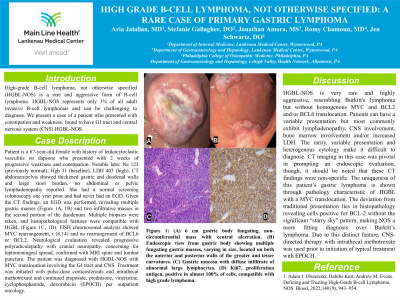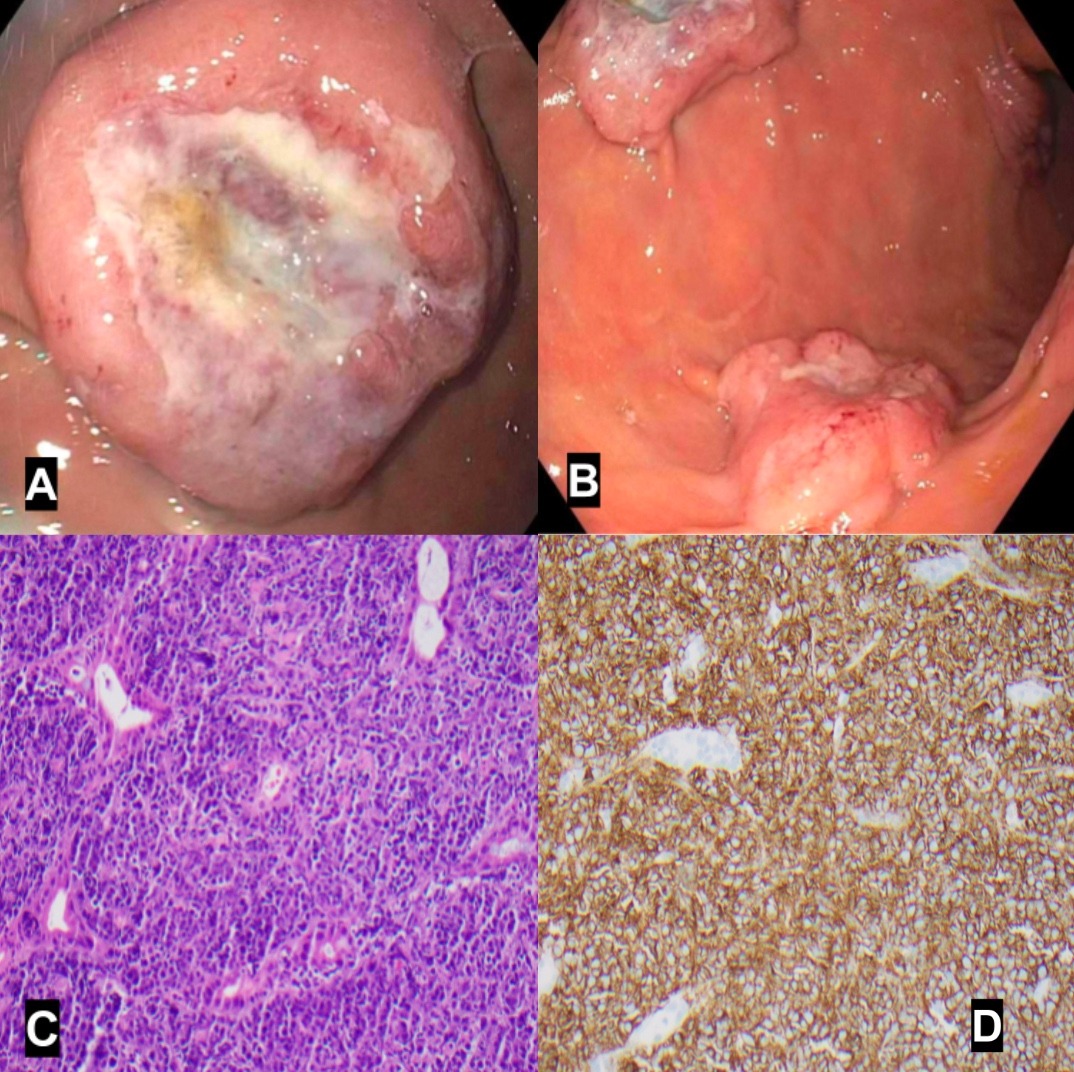Sunday Poster Session
Category: Stomach
P1355 - High Grade B-Cell Lymphoma, Not Otherwise Specified: A Rare Case of Primary Gastric Lymphoma
Sunday, October 22, 2023
3:30 PM - 7:00 PM PT
Location: Exhibit Hall

Has Audio

Aria Jalalian, MD
Lankenau Medical Center
Wynnewood, PA
Presenting Author(s)
Aria Jalalian, MD1, Stefanie Gallagher, DO1, Jonathan Amora, MS2, Romy Chamoun, MD1, Jen Schwartz, DO1
1Lankenau Medical Center, Wynnewood, PA; 2PCOM, Philadelphia, PA
Introduction: High-grade B-cell lymphoma, not otherwise specified (HGBL-NOS) is a rare and aggressive form of B-cell lymphoma. We present a case of a patient who presented with constipation and weakness, found to have GI tract and central nervous system (CNS) HGBL-NOS.
Case Description/Methods: Patient is a 67 year-old female with a history of leukocytoclastic vasculitis who reported two weeks of constipation and progressive weakness. Labs: Na 123 (previously normal) and Hgb 11 (baseline). CT abdomen/pelvis showed thickened gastric and duodenal walls and large stool burden, but no abdominal or pelvic lymphadenopathy. She had no EGD and had a normal screening colonoscopy one year prior. She underwent an EGD which showed multiple gastric masses, as large as 6 cm (Figure 1A, 1B), and two infiltrative masses in the second portion of the duodenum. Biopsies showed histopathological features compatible with high-grade B-cell lymphoma (HGBL) (Figure 1C, 1D). FISH chromosomal analysis: MYC rearrangement, t (8,14) and no rearrangement of BCL6 or BCL2. Neurological evaluation revealed progressive polyradiculopathy with cranial neuropathy, concerning for leptomeningeal spread; this was confirmed with MRI spine and lumbar puncture. She was diagnosed with HGBL, not otherwise specified (NOS) with MYC translocation involving the GI tract and CNS. Treatment was initiated with pulse-dose corticosteroids and intrathecal methotrexate and continued etoposide, prednisone, vincristine, cyclophosphamide, doxorubicin (EPOCH) per outpatient oncology.
Discussion: What initially appeared a typical presentation of constipation evolved into a diagnosis of stage IV HGBL-NOS. HGBL-NOS represents only 3% of all adult invasive B-cell lymphomas and can be challenging to diagnose. The uniqueness of this patient’s gastric lymphoma is shown through pathology characteristic of HGBL with a MYC translocation. The deviation from traditional presentation lies in histopathology revealing cells positive for BCL-2 without the significant “starry sky” pattern, making NOS a more fitting diagnosis over Burkitt’s lymphoma. Due to this distinct feature, CNS-directed therapy with intrathecal methotrexate was used prior to initiation of typical treatment with EPOCH.
Adam J. Olszewski, Habibe Kurt, Andrew M. Evens. Defining and Treating High-Grade B-cell Lymphoma, NOS. Blood, 2022;140 (9), 943–954.

Disclosures:
Aria Jalalian, MD1, Stefanie Gallagher, DO1, Jonathan Amora, MS2, Romy Chamoun, MD1, Jen Schwartz, DO1. P1355 - High Grade B-Cell Lymphoma, Not Otherwise Specified: A Rare Case of Primary Gastric Lymphoma, ACG 2023 Annual Scientific Meeting Abstracts. Vancouver, BC, Canada: American College of Gastroenterology.
1Lankenau Medical Center, Wynnewood, PA; 2PCOM, Philadelphia, PA
Introduction: High-grade B-cell lymphoma, not otherwise specified (HGBL-NOS) is a rare and aggressive form of B-cell lymphoma. We present a case of a patient who presented with constipation and weakness, found to have GI tract and central nervous system (CNS) HGBL-NOS.
Case Description/Methods: Patient is a 67 year-old female with a history of leukocytoclastic vasculitis who reported two weeks of constipation and progressive weakness. Labs: Na 123 (previously normal) and Hgb 11 (baseline). CT abdomen/pelvis showed thickened gastric and duodenal walls and large stool burden, but no abdominal or pelvic lymphadenopathy. She had no EGD and had a normal screening colonoscopy one year prior. She underwent an EGD which showed multiple gastric masses, as large as 6 cm (Figure 1A, 1B), and two infiltrative masses in the second portion of the duodenum. Biopsies showed histopathological features compatible with high-grade B-cell lymphoma (HGBL) (Figure 1C, 1D). FISH chromosomal analysis: MYC rearrangement, t (8,14) and no rearrangement of BCL6 or BCL2. Neurological evaluation revealed progressive polyradiculopathy with cranial neuropathy, concerning for leptomeningeal spread; this was confirmed with MRI spine and lumbar puncture. She was diagnosed with HGBL, not otherwise specified (NOS) with MYC translocation involving the GI tract and CNS. Treatment was initiated with pulse-dose corticosteroids and intrathecal methotrexate and continued etoposide, prednisone, vincristine, cyclophosphamide, doxorubicin (EPOCH) per outpatient oncology.
Discussion: What initially appeared a typical presentation of constipation evolved into a diagnosis of stage IV HGBL-NOS. HGBL-NOS represents only 3% of all adult invasive B-cell lymphomas and can be challenging to diagnose. The uniqueness of this patient’s gastric lymphoma is shown through pathology characteristic of HGBL with a MYC translocation. The deviation from traditional presentation lies in histopathology revealing cells positive for BCL-2 without the significant “starry sky” pattern, making NOS a more fitting diagnosis over Burkitt’s lymphoma. Due to this distinct feature, CNS-directed therapy with intrathecal methotrexate was used prior to initiation of typical treatment with EPOCH.
Adam J. Olszewski, Habibe Kurt, Andrew M. Evens. Defining and Treating High-Grade B-cell Lymphoma, NOS. Blood, 2022;140 (9), 943–954.

Figure: Figure 1: (A) 6 cm gastric body fungating, non-circumferential mass with central ulceration. (B) Endoscopic view from gastric body showing multiple fungating gastric masses, varying in size, located on both the anterior and posterior walls of the greater and lesser curvatures. (C) Gastric mucosa with diffuse infiltrate of abnormal large lymphocytes. (D) Ki67, proliferation antigen, positive in almost 100% of cells, compatible with high grade lymphoma.
Disclosures:
Aria Jalalian indicated no relevant financial relationships.
Stefanie Gallagher indicated no relevant financial relationships.
Jonathan Amora indicated no relevant financial relationships.
Romy Chamoun indicated no relevant financial relationships.
Jen Schwartz indicated no relevant financial relationships.
Aria Jalalian, MD1, Stefanie Gallagher, DO1, Jonathan Amora, MS2, Romy Chamoun, MD1, Jen Schwartz, DO1. P1355 - High Grade B-Cell Lymphoma, Not Otherwise Specified: A Rare Case of Primary Gastric Lymphoma, ACG 2023 Annual Scientific Meeting Abstracts. Vancouver, BC, Canada: American College of Gastroenterology.
